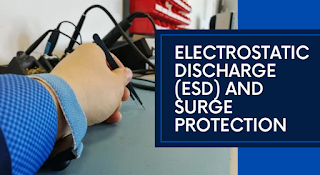Electrostatic Discharge (ESD) and Surge Protection
Electrostatic discharge (ESD) is an unintended quick high-voltage transient waveform that appears on conductors within an electrical circuit[2]. It occurs when bodies with different electrostatic potential approach each other, resulting in a charge exchange and a brief surge voltage[3]. ESD can cause damage to sensitive electronic components and even injury to human life[4]. In this blog, we will discuss the importance of ESD and surge protection in various industries and provide insights into ESD control measures and surge protection devices.
ESD in Electronics-Related Industries
ESD is a significant concern in industries that handle sensitive electronic components, as it can cause damage to these components and affect their performance[4]. Some key industries that require ESD control measures include:
– Electronics manufacturing
– Telecommunications
– Medical devices
– Consumer electronics
ESD Control Measures
To minimize the negative effects of ESD events, companies should implement a comprehensive ESD control program that takes into account the entire ESD environment. Some common ESD control measures include:
1. ESD control flooring: ESD conductive flooring treatments and dissipative flooring materials can help dissipate static electricity and reduce the risk of ESD events.
2. Personal protective equipment (PPE): Providing workers with appropriate PPE, such as antistatic wrist straps and mats, can help prevent the buildup of static electricity in the body.
3. Packaging and storage: Proper packaging and storage of sensitive electronic components can help prevent ESD events during transportation and handling.
Surge Protection Devices
Surge protection devices are essential for protecting electronic components and systems from surge voltages caused by external factors such as lightning strikes or power line fluctuations[3]. Some common surge protection devices include:
1. Ceramic capacitors: These are inexpensive and small, but they may not be effective against high-power ESD events.
2. IEC 61000-4: This standard provides guidelines for testing and measuring the susceptibility of electronic systems to ESD and surge voltages.
3. Transient Voltage Suppressors (TVS): These devices can protect sensitive components against transient voltages caused by ESD and other factors.
ESD and Surge Protection Standards
There are several international standards and recommendations that provide guidelines for ESD control and surge protection in various industries[5]. Some of these standards include:
– IEC 61000-4-2: Electrostatic Discharge Immunity Test
– IEC 61000-4-4: Testing and measurement techniques – Electrical fast transient/burst immunity test
– IEC 61000-4-5: Surge Immunity Test
– IEEE C62.41.2: Recommended Practice on Characterization of Surge Voltages in Low-Voltage (1000 V and less) AC Power Circuits
Electrostatic discharge and surge protection are crucial concerns in industries that handle sensitive electronic components. Implementing a comprehensive ESD control program and using appropriate surge protection devices can help minimize the risk of ESD events and ensure the proper functioning of electronic systems. By adhering to relevant industry standards and guidelines, companies can better protect their employees, property, and products from the damaging effects of ESD and surge voltages.




